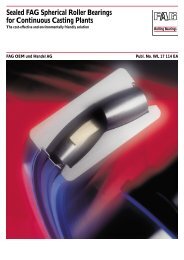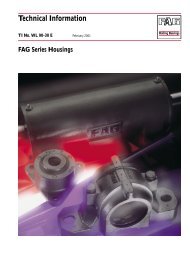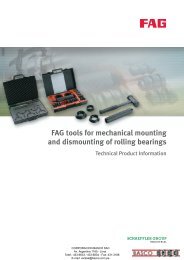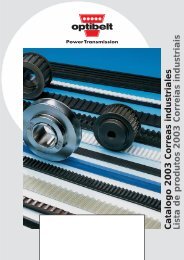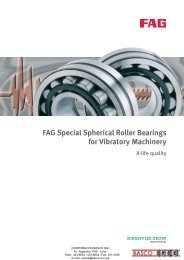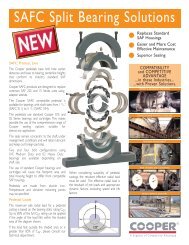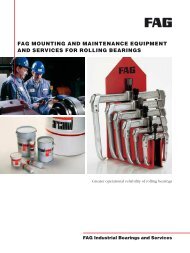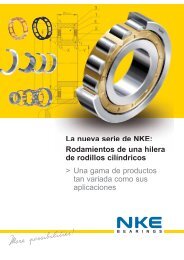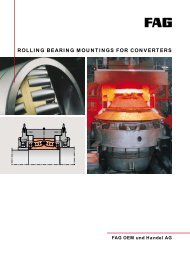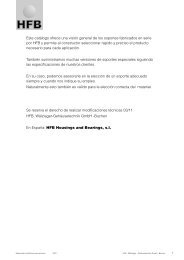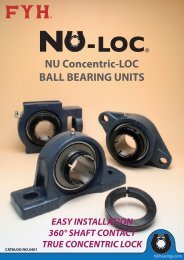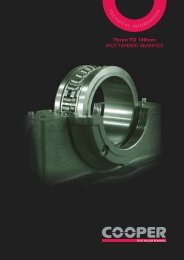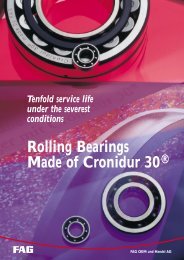Create successful ePaper yourself
Turn your PDF publications into a flip-book with our unique Google optimized e-Paper software.
GlossaryEP additivesWear-reducing additives in lubricating greases and lubricatingoils, also referred to as extreme pressure lubricants.Equivalent dynamic load PFor dynamically loaded rolling bearings operatingunder a combined load, the calculation is based on theequivalent dynamic load. This is a radial load for radialbearings and an axial and centrical load for axial bearings,having the same effect on fatigue as the combinedload. <strong>The</strong> equivalent dynamic load P is calculated bymeans <strong>of</strong> the following equation:P = X · F r + Y · F a[kN]F r radial load [kN]F a axial load [kN]X radial factor (see FAG catalogues)Y thrust factor (see FAG catalogues)Equivalent static load P 0Statically stressed rolling bearings which operate undera combined load are calculated with the equivalent staticload. It is a radial load for radial bearings and anaxial and centric load for thrust bearings, having thesame effect with regard to permanent deformation asthe combined load.<strong>The</strong> equivalent static load P 0 is calculated with theformula:P = X 0 · F r + Y 0 · F a[kN]F r radial load [kN]F a axial load [kN]X 0 radial factor (see FAG catalogues)Y 0 thrust factor (see FAG catalogues)Factor a 1Generally (nominal rating life L 10 ), 10 % failure probabilityis taken. <strong>The</strong> factor a 1 is also used for failureprobabilities between 10 % and 1 % for the calculation<strong>of</strong> the attainable life, see following table.Failureprobability % 10 5 4 3 2 1Fatiguelife L 10 L 5 L 4 L 3 L 2 L 1Factor a 1 1 0.62 0.53 0.44 0.33 0.21Factor a 23 (life adjustment factor)<strong>The</strong> a 23 factor is used to calculate the attainable life.FAG use a 23 instead <strong>of</strong> the mutually dependent adjustmentfactors for material (a 2 ) and operating conditions(a 3 ) indicated in DIN ISO 281.a 23 = a 2 · a 3<strong>The</strong> a 23 factor takes into account effects <strong>of</strong>:– amount <strong>of</strong> load (stress index f s* ),– lubricating film thickness (viscosity ratio ),– lubricant additives (value K),– contaminants in the lubricating gap (cleanlinessfactor s),– bearing type (value K).<strong>The</strong> diagram on page 185 is the basis for the determination<strong>of</strong> the a 23 factor using the basic a 23II value. <strong>The</strong>a 23 factor is obtained from the equation a 23II · s (s beingthe cleanliness factor).<strong>The</strong> viscosity ratio = / 1 and the value K are requiredfor locating the basic value. <strong>The</strong> most important zone(II) in the diagram applies to normal cleanliness(s = 1).<strong>The</strong> viscosity ratio is a measure <strong>of</strong> the lubricating filmdevelopment in the bearing. operating viscosity <strong>of</strong> the lubricant, depending on thenominal viscosity (at 40 °C) and the operating temperaturet (fig. 1). In the case <strong>of</strong> lubricating greases, is the operating viscosity <strong>of</strong> the base oil. 1 rated viscosity, depending on mean bearing diameterd m and operating speed n (fig. 2).<strong>The</strong> diagram (fig. 3) for determining the basic a 23IIfactor is subdivided into zones I, II and III.Most applications in rolling bearing engineering arecovered by zone II. It applies to normal cleanliness(contamination factor V = 1). In zone II, a 23 can be determinedas a function <strong>of</strong> by means <strong>of</strong> value K.With K = 0 to 6, a 23II is found on one <strong>of</strong> the curves inzone II <strong>of</strong> the diagram.With K > 6, a 23 must be expected to be in zone III. Insuch a case conditions should be improved so thatzone II can be reached.FAG 184



